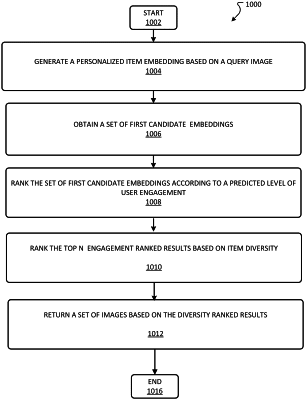| CPC G06F 16/535 (2019.01) [G06F 16/532 (2019.01); G06F 16/56 (2019.01)] | 18 Claims |

|
1. A method for returning personalized image-based search results, the method comprising:
receiving a query including an image;
generating a personalized item embedding based on the image and user profile information associated with a user;
obtaining a plurality of candidate images based on the personalized item embedding;
ranking the plurality of candidate images according to a predicted level of user engagement for the user;
obtaining a diversified final set of image results from the ranked plurality of candidate images utilizing a feature vector related to content-based features associated with the ranked plurality of candidate images to increase a distance between images in the final set of image results such that the final set of image results have increased visual differences between images in the final set of images results;
returning the final set of image results;
receiving a second query including the same image;
generating a second personalized item embedding based on the image and user profile information associated with a second user;
obtaining a second plurality of candidate images based on the second personalized item embedding, wherein the second plurality of candidate images are different from the plurality of candidate images;
ranking the second plurality of candidate images according to a predicted level of user engagement for the second user;
obtaining a diversified second final set of image results from the second ranked plurality of candidate images utilizing a feature vector related to content-based features associated with the second ranked plurality of candidate images to increase a distance between images in the second final set of image results such that the second final set of image results have increased visual differences between images in the second final set; and
returning a portion of the second final set of image results.
|